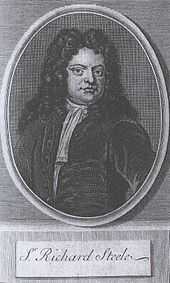Tatler (1709 journal)
| Categories | Fashion |
|---|---|
| Frequency | Tri-weekly |
| First issue | 1709 |
| Country | United Kingdom |
| Language | English |
Tatler was a British literary and society journal founded by Richard Steele in 1709. It was published for two years.
1709 journal
Tatler was founded in 1709 by Richard Steele, who used the nom de plume "Isaac Bickerstaff, Esquire". This is the first known such consistently adopted journalistic persona,[1] which adapted to the first person, as it were, the 17th-century genre of "characters", as first established in English by Sir Thomas Overbury and then expanded by Lord Shaftesbury's Characteristics (1711). Steele's idea was to publish the news and gossip heard in London coffeehouses, hence the title, and seemingly, from the opening paragraph, to leave the subject of politics to the newspapers,[2] while presenting Whiggish views and correcting middle-class manners, while instructing "these Gentlemen, for the most part being Persons of strong Zeal, and weak Intellects...what to think." To assure complete coverage of local gossip, a reporter was placed in each of the city's popular coffeehouses, or at least such were the datelines: accounts of manners and mores were datelined from White's; literary notes from Will's; notes of antiquarian interest were dated from the Grecian Coffee House; and news items from St. James's Coffee House.
The journal was originally published three times a week, including contributions from Jonathan Swift and Joseph Addison. The original Tatler was published for only two years, from 12 April 1709 to 2 January 1711. A collected edition was published in 1710–11, with the title The Lucubrations of Isaac Bickerstaff, Esq.[3] Two months after the final edition, Steele and Addison co-founded The Spectator magazine.
Subsequent incarnations
Several later journals revived the name Tatler.[4] Three short series are preserved in the Burney Collection:[5]
- John Morphew, the original printer, continued to produce further issues in 1711 under the "Isaac Bickerstaffe" name from 4 January (No. 272) to 17 May (No. 330).
- A single issue (numbered 1) of a rival Tatler was published by Baldwin on 11 January 1711.
- In 1753–4, several issues by "William Bickerstaffe, nephew of the late Isaac Bickerstaffe" were published.
James Watson, who had previously reprinted the London Tatler in Edinburgh, began his own Tatler there on 13 January 1711, with "Donald Macstaff of the North" replacing Isaac Bickerstaffe.[6]
Three months after the original Tatler was first published, an unknown woman writer using the pen name "Mrs. Crackenthorpe" published what was called the Female Tatler. Scholars from the 1960s to the 1990s thought the anonymous woman might have been Delarivier Manley, but she was subsequently ruled out as author and the woman remains unknown. However, its run was much shorter: the magazine ran for less than a year—from 8 July 1709 to 31 March 1710.[7] The London Tatler[8] and the Northern Tatler[9] were later 18th-century imitations. The Tatler Reviv'd ran for 17 issues from October 1727 to January 1728; another publication of the same name had six issues in March 1750.[10]
On 4 September 1830, Leigh Hunt launched The Tatler: A Daily Journal of Literature and the Stage. He edited it till 13 February 1832, and others continued it till 20 October 1832.[11]
In July 1901, Clement Shorter, the publisher of The Sphere, introduced a magazine called Tatler, named after Steele's periodical. After several mergers and name changes it was still in print a hundred years later, owned by Condé Nast Publications.
References
- ↑ Bonamy Dobrée, 1959. English Literature in the Early Eighteenth Century 1700–1740 in series Oxford History of English Literature, pp 77–83.
- ↑ "principally intended for the Use of Politick Persons who are so publick-spirited as to neglect their own affairs to look into Transactions of State."
- ↑ The Tatler, Literary Encyclopaedia
- ↑ 300 Years of Telling Tales, Britain’s Tatler Still Thrives Eric Pfaner, New York Times, 5 October 2009, p.B7
- ↑ 17th–18th Century Burney Collection Newspapers Title List, Gale
- ↑ Marr, George Simpson (1923). The periodical essayists of the eighteenth century. London: J. Clarke. p. 29.
- ↑ Issuing her Own: the Female Tatler, Latha Reddy and Rebecca Gershenson Smith, 2002. (Site includes sample issues #41 and #67)
- ↑ Marr, George Simpson (1923). The periodical essayists of the eighteenth century. London: J. Clarke. p. 72.
- ↑ Marr, George Simpson (1923). The periodical essayists of the eighteenth century. London: J. Clarke. p. 96.
- ↑ George Watson, ed. (1971). The New Cambridge Bibliography of English Literature. Volume 2; Volumes 1660–1800. Cambridge University Press. col.1330,1332. ISBN 0-521-07934-9.
- ↑ Ireland, Alexander (1868). List of the writings of William Hazlitt and Leigh Hunt. John Russell Smith. pp. 143–8.
Further reading
- "The Story of Tatler: A 300-year frolic through Tatler's history, from coffee-house tri-weekly to glossy monthly". Tatler: 71–114. November 2009.
- Henry W. Kent (1903). "Tatler". Bibliographical Notes on One Hundred Books Famous in English Literature. NY: Grolier Club.
External links
- The Tatler and The Guardian
- The Tatler, Vol. 1 at Project Gutenberg (An 1899 reprint of the first 49 Issues of the 1709 Tatler)
